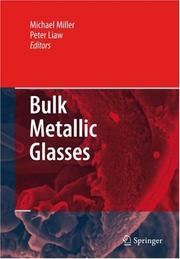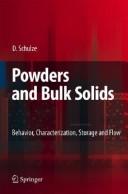| Listing 1 - 4 of 4 |
Sort by
|
Book
ISBN: 3030767205 3030767191 Year: 2021 Publisher: Cham, Switzerland : Springer,
Abstract | Keywords | Export | Availability | Bookmark
 Loading...
Loading...Choose an application
- Reference Manager
- EndNote
- RefWorks (Direct export to RefWorks)
Bulk solids. --- Bulk materials --- Particulate solids --- Materials --- Particles --- Solids

ISBN: 1281336920 9786611336929 0387489215 0387489207 1441943137 Year: 2008 Publisher: New York : Springer,
Abstract | Keywords | Export | Availability | Bookmark
 Loading...
Loading...Choose an application
- Reference Manager
- EndNote
- RefWorks (Direct export to RefWorks)
Bulk Metallic Glasses explores an emerging field of materials known as bulk metallic glasses. It summarizes the rapid development of these materials over the last decade and includes documentation on diverse applications of bulk metallic glasses; from structural applications to microcomponents. Some of the applications covered are pressure sensors, microgears for motors, magnetic cores for power supplies, and nano-dies for replacing next generation DVDs. The chapters cover current theories and recent research including an atomistic theory of local topological fluctuations, atomistic simulations, and unique microstructures of these amorphous materials. Other topics include glass formation, glass forming ability, and the underlying mechanisms and physical insights of these criteria. The mechanical deformation of bulk metallic glasses, fatigue, fracture, and corrosion behaviors of these materials are also reviewed. Bulk Metallic Glasses is a valuable resource for graduate and under-graduate students as well as professors, engineers, and researchers.
Metallic glasses. --- Bulk solids. --- Bulk materials --- Particulate solids --- Materials --- Particles --- Solids --- Glasses, Metallic --- Glassy alloys --- Glassy metals --- Alloys --- Amorphous substances --- Liquid metals --- Materials. --- Nanotechnology. --- Surfaces (Physics). --- Metallic Materials. --- Characterization and Evaluation of Materials. --- Ceramics, Glass, Composites, Natural Materials. --- Molecular technology --- Nanoscale technology --- High technology --- Engineering --- Engineering materials --- Industrial materials --- Engineering design --- Manufacturing processes --- Physics --- Surface chemistry --- Surfaces (Technology) --- Metals. --- Materials science. --- Ceramics. --- Glass. --- Composites (Materials). --- Composite materials. --- Composites (Materials) --- Multiphase materials --- Reinforced solids --- Solids, Reinforced --- Two phase materials --- Ceramics --- Glazing --- Ceramic technology --- Industrial ceramics --- Keramics --- Building materials --- Chemistry, Technical --- Clay --- Material science --- Physical sciences --- Metallic elements --- Chemical elements --- Ores --- Metallurgy
Book
ISBN: 3658316055 3658316047 Year: 2021 Publisher: Wiesbaden, Germany : Springer Vieweg,
Abstract | Keywords | Export | Availability | Bookmark
 Loading...
Loading...Choose an application
- Reference Manager
- EndNote
- RefWorks (Direct export to RefWorks)
This thesis investigates the fracture of nearly incompressible hyperelastic media. It covers the different characteristics of bulk material failure under dilatational or distortional loads and develops a unified description of the corresponding failure surface. It proposes a coupled strain and energy failure criterion for the assessment of notch-induced crack nucleation and presents a weak-interface-model that allows for efficient stress, strain and failure analyses of hyperelastic adhesive lap joints. Theoretical concepts for the measurement of fracture properties of nonlinear elastic materials are provided. The methodology is developed using two exemplary hyperelastic silicones, DOWSIL 993 Structural Glazing Sealant and DOWSIL Transparent Structural Silicone Adhesive, and is validated using large sets of experiments of different loading conditions. Philipp Rosendahl studied mechanical engineering at the Technical University of Darmstadt, the University of Illinois at Urbana-Champaign and the Royal Institute of Technology in Stockholm. His doctoral thesis on the fracture mechanics of thin layers opened applications to problems of structural engineering such as adhesive bonding in the fields of mechanical and civil engineering and to geophysical problems such as skier-triggered snow slab avalanche release. The author is currently working as the Junior Research Group Head for Structural Mechanics and Additive Manufacturing of the Institute of Structural Mechanics and Design at the Technical University of Darmstadt and co-founded the startup company 2phi, which aims at improving skier safety in the backcountry by transferring scientific advances into practice.
Building materials. --- Buildings—Design and construction. --- Building. --- Construction. --- Engineering, Architectural. --- Building—Superintendence. --- Construction industry—Management. --- Construction superintendence. --- Building Materials. --- Building Construction and Design. --- Construction Management. --- Building superintendence --- Construction superintendence --- Construction superintending --- Construction industry --- Architectural engineering --- Buildings --- Construction --- Construction science --- Engineering, Architectural --- Structural design --- Structural engineering --- Architecture --- Architectural materials --- Building --- Building supplies --- Construction materials --- Structural materials --- Materials --- Management --- Design and construction --- Fracture mechanics. --- Elastomers --- Bulk solids --- Cracking. --- Failure of solids --- Fracture of materials --- Fracture of solids --- Mechanics, Fracture --- Solids --- Deformations (Mechanics) --- Strength of materials --- Brittleness --- Penetration mechanics --- Structural failures --- Fracture --- Fatigue --- Bulk materials --- Particulate solids --- Particles --- Elastomeric materials --- Reinforced elastomers --- Polymers --- Plastics --- Rubber

ISBN: 1281355119 9786611355111 3540737685 3540737677 3642092985 Year: 2007 Publisher: Berlin : Springer-Verlag,
Abstract | Keywords | Export | Availability | Bookmark
 Loading...
Loading...Choose an application
- Reference Manager
- EndNote
- RefWorks (Direct export to RefWorks)
The book concentrates on powder flow properties, their measurement and applications. These topics are explained starting from the interactions between individual particles up to the design of silos. A wide range of problems are discussed – such as flow obstructions, segregation, and vibrations. The goal is to provide a deeper understanding of the powder flow, and to show practical solutions. In the first part the fundamentals of bulk solids flow are outlined: particle-particle interactions, stress, friction, strength, density, flow properties and methods of measurement, shear testers and other test procedures, specific properties of powders and how they are influenced by moisture, temperature, and flow agents. The second part deals with the application of the flow properties in the design of properly working bulk solid containers like bins, silos, and hoppers. Other topics include: the technical design of silo walls, feeders, discharge aids, inserts, the assessment of stresses in silos, segregation and how to avoid it, and vibrations or shocks occurring in silos.
Bulk solids flow. --- Bulk solids handling. --- Bulk solids. --- Industrial engineering. --- System safety. --- Safety, System --- Safety of systems --- Systems safety --- Management engineering --- Simplification in industry --- Bulk materials --- Particulate solids --- Handling of bulk solids --- Dry-solids flow --- Flow of bulk solids --- Solids flow, Bulk --- Chemistry. --- Pharmacy. --- Chemical engineering. --- Agriculture. --- Control engineering. --- Robotics. --- Mechatronics. --- Production engineering. --- Quality control. --- Reliability. --- Industrial safety. --- Industrial Chemistry/Chemical Engineering. --- Industrial and Production Engineering. --- Quality Control, Reliability, Safety and Risk. --- Control, Robotics, Mechatronics. --- Engineering --- Value analysis (Cost control) --- Accidents --- Industrial safety --- Systems engineering --- Materials --- Particles --- Solids --- Materials handling --- Fluid dynamics --- Prevention --- Farming --- Husbandry --- Industrial arts --- Life sciences --- Food supply --- Land use, Rural --- Chemistry --- Medicine --- Drugs --- Materia medica --- Pharmacology --- Chemistry, Industrial --- Engineering, Chemical --- Industrial chemistry --- Chemistry, Technical --- Metallurgy --- Manufacturing engineering --- Process engineering --- Industrial engineering --- Mechanical engineering --- Control engineering --- Control equipment --- Control theory --- Engineering instruments --- Automation --- Programmable controllers --- Industrial accidents --- Industries --- Job safety --- Occupational hazards, Prevention of --- Occupational health and safety --- Occupational safety and health --- Prevention of industrial accidents --- Prevention of occupational hazards --- Safety, Industrial --- Safety engineering --- Safety measures --- Safety of workers --- System safety --- Dependability --- Trustworthiness --- Conduct of life --- Factory management --- Reliability (Engineering) --- Sampling (Statistics) --- Standardization --- Quality assurance --- Quality of products --- Microelectronics --- Microelectromechanical systems --- Machine theory
| Listing 1 - 4 of 4 |
Sort by
|

 Search
Search Feedback
Feedback About UniCat
About UniCat  Help
Help News
News